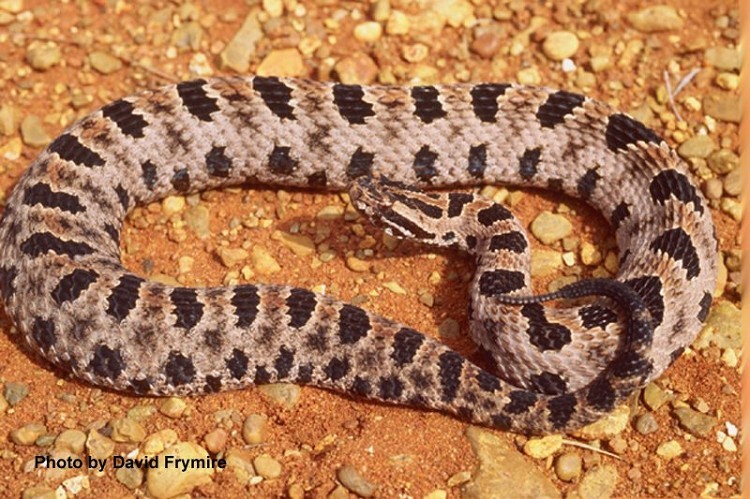Pygmy Rattlesnake
The Pygmy Rattlesnake (also Pigmy) is the smallest, and one of the least known, venomous snakes in Tennessee. One subspecies, the Western Pygmy Rattlesnake (S. m. streckeri), occurs along the western Highland Rim from Stewart County to the southern border.
Description: A small, colorful rattlesnake (15.0 to 20.0 inches in length) with a vertical pupil, thin tail, and tiny rattle. The body color is gray or tan with an orangish-brown mid-dorsal stripe usually present. There are dark blotches, typically bar-shaped, running along the length of the back with one or two rows of dark spots along each side of the body.
The head has a wide, black stripe that starts at the eye and slopes down to the corner of the mouth; the crown of the head also has 9 large plates. The belly is a dusky cream-color mottled with dark bars. Scales are keeled. Young have yellow-tipped tails.
Similar Species: Timber Rattlesnake is much larger and has small scales on the crown of the head.
Habitat: Found in a variety of habitats, but is usually in close proximity to water. Occurs in flood plains, wetlands, and moist fields; occasionally found in rocky uplands, pine woods, and glades.
Diet: Prefers frogs, lizards, small snakes, amphibians, and small rodents.
Breeding information: Very little reproductive information on the Western Pygmy Rattlesnake. They are presumed to breed in the spring as 3-7 live young are born in late summer.
Status in Tennessee: Western Pygmy Rattlesnake is listed as Threatened by TWRA, and considered rare to very rare and imperiled by the Tennessee Department of Environment and Conservation.
Fun Facts:
- The tiny rattle sounds like the faint buzz of an insect and can usually be heard no farther than 3 feet.
- Pygmy Rattlesnakes are good swimmers.
Best places to see in Tennessee: Near water at Land Between the Lakes.
